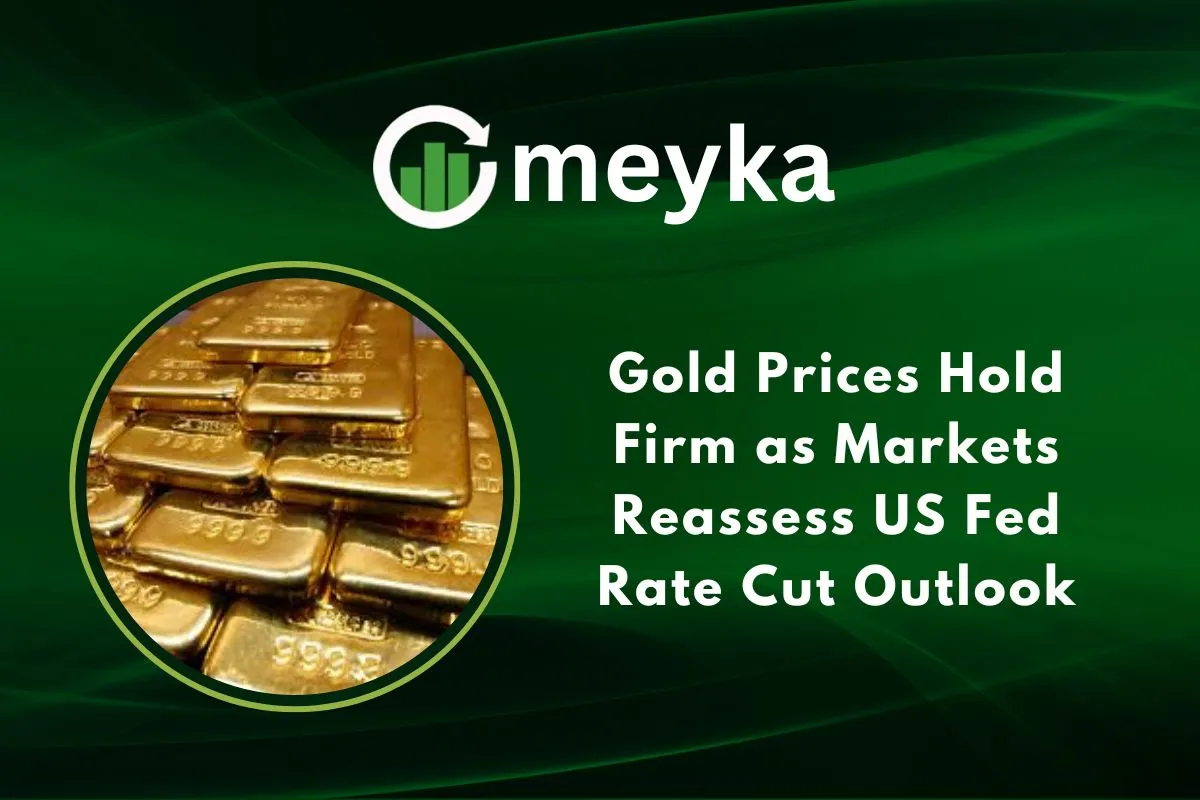Gold Prices Hold Firm as Markets Reassess US Fed Rate Cut Outlook
Gold is holding its ground even as markets rethink when, or if, the Federal Reserve (Fed) will cut interest rates. Investors are growing more cautious about near-term rate cuts, and that uncertainty is helping to firm up gold prices. We’re watching this closely. In a world where “Rate Cut” bets once gave bullion a strong tailwind, the tables might be turning. Rather than rallying wildly, gold is now showing resilience, almost calm amid the storm of shifting expectations.
Why? Because gold is not just a shiny metal. It’s a haven. When markets are unsure about the Fed’s next move, or when inflation stays sticky, people turn to gold. Add to that a shaky macro picture, and suddenly gold feels more valuable than ever. We’ll explore why gold is staying strong, how the Fed’s wavering signal is shaping investor sentiment, and what could come next.
What’s Driving Gold Prices Right Now?
Gold prices have been pretty stable lately, even while the surrounding conditions are chaotic. For example, spot gold slipped to around US $4,063.81 per ounce when the dollar strengthened and rate-cut hopes faded.
The key drivers are multiple:
- Strong U.S. data: When jobs, inflation, or the economy surprise on the upside, the market moves away from expecting a “Rate Cut.” That hurts gold.
- Dollar strength and higher yields: A stronger dollar often makes gold costlier for non-US buyers and reduces demand. When yields on U.S. Treasuries rise, the opportunity cost of holding gold (which pays no interest) goes up.
- Safe-haven demand: Even when rate-cut hopes dim, gold still benefits from global risks, geopolitical tensions, inflation fears, and merging market weakness. This is supporting gold’s floor.
So we have a mix: less hope of rate cuts (which could hurt gold) but higher safe-asset demand (which could help). That results in a somewhat “firm but cautious” gold market.
Fed Rate Cut Outlook: Why the Market Is Reassessing
The notion of a near-term rate cut by the Fed is under pressure. Markets had priced in more generous odds of cuts, but that has changed. For example, the probability of a December cut dropped from nearly 49% to around 33%.
Why the shift?
- Inflation remains sticky. Even though there are signs of easing, inflation is still above target, making the Fed cautious.
- The labour market is stronger than expected. When jobs keep adding and unemployment remains low, the Fed may hold back on a cut.
- Fed rhetoric has been hawkish: Officials have warned of holding tight until more data arrive. That reduces the certainty of a “Rate Cut.”
- Bond market yield moves and forward curves reflect the reassessment: Real yields are not dropping as fast, and that feeds into gold dynamics.
So the “Rate Cut” theme remains central. Markets are asking: Will there be one? When? And how big? Until the answers become clearer, gold remains in a wait-and-see mode.
Why Steady Rates Support Gold
It might seem counterintuitive, but gold can benefit when rate cuts don’t happen right away. Here’s why:
- Opportunity cost: Gold doesn’t pay interest. If rates are falling or expected to fall, holding gold becomes relatively more attractive. But if top rates stay for longer, then the benefit is slower, but the uncertainty stays. That uncertainty can support gold since some demand comes from hedging.
- Real yields: If nominal yields stay high but inflation stays elevated, real yields (yield minus inflation) may stay low or negative, good for gold. When real yields drop, gold tends to shine.
- Safe-haven status: With the Fed signalling “wait and see,” we get an environment of uncertainty and risk. Investors gravitate toward assets like gold in those conditions.
- Central bank and investment flows: Some central banks continue adding gold to reserves, and ETFs are seeing inflows or remain steady. That helps underpin demand.
In short, straight rate cuts might help gold quickly, but a drawn-out period of uncertainty and stable but high rates can also keep gold firm.
Market Sentiment: What Traders and Analysts Expect Next
What do market participants think? Here are some of the patterns we see:
- Analysts point out key support levels for gold around US$4,073$4,133 per ounce. That band is holding for now.
- Some anticipate a bounce if the Fed formally signals a cut later this year. In that scenario, gold could move higher.
- Others caution: If inflation surprises on the upside, or if the labour market stays hot, then the “Rate Cut” story could be delayed further, which might weigh on gold.
- Investor behaviour: Many are adopting a “buy-on-dips” strategy. They’re cautious, waiting for data. For now, gold is range-bound rather than strongly trending.
So our take: Gold is in a position to benefit if conditions tilt toward a cut. But if the Fed holds firm, gold’s upside remains limited in the short term.
Global Factors Adding Support to Gold
Gold’s story isn’t just about the U.S. rate outlook. Global elements play an important role, too.
- Weak global growth: Emerging markets and some major economies are slowing, increasing safe-asset demand.
- China’s predicament: Slower growth in China affects commodities and global risk appetite, which in turn can boost gold as a hedge.
- Central banks’ behaviour: Many central banks in emerging markets continue to add gold to reserves. That structural demand supports gold.
- Geopolitical risks: Tensions in the Middle East, Europe, and U.S.-China relationships add a risk premium, which tends to help gold.
These global undercurrents suggest that even if the U.S. “Rate Cut” story weakens, gold still has pillars of demand behind it.
What Investors Should Watch
If we’re tracking how this story evolves, here are the key items we’re watching:
- Upcoming U.S. data: Non-farm payrolls, CPI/PCE inflation, GDP revisions. Big surprises either way will affect rate-cut expectations and thus gold.
- Dollar and yield curves: A strong dollar or rising real yields tend to pressure gold. If yields drop or the dollar weakens, gold may rally.
- Fed commentary: Every speech, every Fed minutes release matters. Markets are listening for hints of when the “Rate Cut” will happen.
- Technical levels for gold: Support at US $4,073–$4,133 and resistance around US $4,155 (based on recent readings).
- Global demand signals: Central-bank buying, physical demand (especially in Asia), and safe-haven flows. These may drive a base under gold.
As we from the market-watching community often say, i t’s not just one number that matters, it’s the mix of macro data, policy signals, and global risk factors.
Conclusion
Gold is holding firm in a tricky environment. The mixed signals around the Fed’s “Rate Cut” timing are keeping markets cautious. That caution is helping gold stay supported. If the Fed leans toward cutting rates sooner, gold may get a lift. If the Fed delays further, gold may stall or dip a bit. But global demand and safe-haven needs give gold a strong base. For investors, it’s a time to stay alert. Watch the data, watch policy, and watch the dollar/yield moves. Gold is poised to respond. And in a world where certainty is scarce, gold still stands out for its hedge and safe-asset role.
FAQS:
When the Fed cuts rates, borrowing becomes cheaper. Gold usually rises because lower interest rates reduce the benefit of holding cash or bonds, making safe-haven gold more attractive.
Yes. Powell’s cautious comments about inflation and the economy made investors unsure. Even after a rate cut, gold gave up some gains because markets expect slower cuts ahead.
Gold falls when the dollar strengthens, interest rates rise, or inflation cools. Reduced safe-haven demand and lower investor buying can also push gold prices down.
Disclaimer:
The content shared by Meyka AI PTY LTD is solely for research and informational purposes. Meyka is not a financial advisory service, and the information provided should not be considered investment or trading advice.






